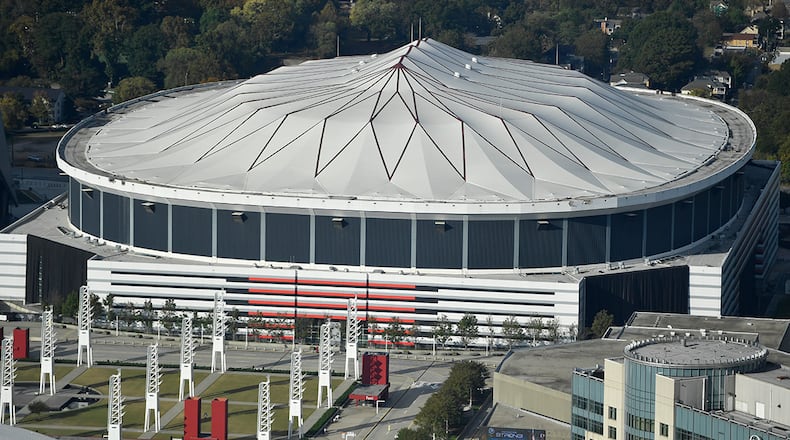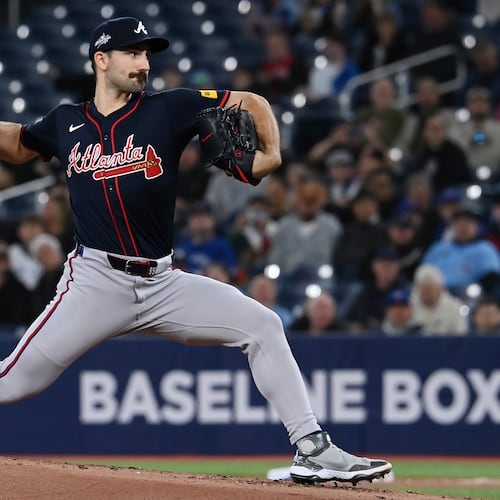In just 12 seconds Monday morning, the Georgia Dome will be reduced to rubble, leaving behind 25 years of memories and a legacy of helping make Atlanta a renowned host of major sports events.
Super Bowls and Final Fours were played there. Olympic gold medals were decided there in three sports. And there were 256 Falcons games, 23 SEC Championship football games, even WrestleMania -- in all, 1,456 events attended by about 39 million people from 1992 through early this year.
No building in Atlanta sports history has hosted more big events.
Live coverage of Dome implosion starts at 4:30 a.m. Monday on Channel 2 Action News This Morning
But with the push of a button at 7:30 a.m. Monday, the Georgia Dome will be imploded, the same fate that befell Atlanta-Fulton County Stadium and the Omni coliseum 20 years earlier.
“It’s going to be a sad day,” said Ken Jefferson, who worked at the Dome from its opening through its closing. “To me, it’s been like watching a loved one die.”
Carl Adkins, the Dome’s former general manager, usually averts his eyes when he drives by the building these days.
“I’d rather remember the good times,” he said. “The memories will always remain, even when the building is gone.”
Ah, the memories: Kerri Strug famously landing a vault despite an injured ankle to clinch the United States’ first Olympic gold medal in women’s team gymnastics; an NBA-record crowd of 62,046 watching Michael Jordan’s Chicago Bulls play the Hawks while Philips Arena was under construction; a Super Bowl that ended one yard shy of a tying touchdown; so many more.
The Falcons’ desire for a new stadium with all the latest bells and whistles and revenue streams spelled the Dome’s demise, even though the building remained in good condition through its final years.
The Dome hosted its final football game Jan. 22, the Falcons’ rousing victory over Green Bay in the NFC Championship game, and its final event March 5, a Monster Jam trucks show.
Engineering an implosion
In recent months, as Mercedes-Benz Stadium opened next door, the Georgia Dome has been unceremoniously emptied and gutted.
“People think we just put dynamite in a few days before and implode the structure,” said Rick Cuppetilli, executive vice president of the lead demolition contractor, Detroit-based Adamo Group. “No, there were four months and 35,000-plus man-hours involved to (get to this point).”
The seats and scoreboards have been removed, interior walls knocked down, glass removed, countless truckloads of debris hauled off.
The structure has been weakened and fractured to soften it for what will hit it Monday morning: 4,800 pounds of explosives placed in almost 3,500 strategically drilled holes and connected by seven miles of wire and cord.
As 7:30 a.m. approaches, demolition personnel, along with police and fire departments personnel, will operate from a command center on the opposite side of Northside Drive, Cuppetilli said.
“The leaders will be huddled to give the all-clear,” he said, “and then there will be a countdown before it goes off.”
Steve Pettigrew, of explosives subcontractor Pettigrew Inc., is slated to push the button on an electronic ignitor – “a device,” Cuppetilli said, “that looks similar to a cellphone.”
Once the button is pushed, he said, “there will be a 12-second period in which all the explosives will go off and the structure falls.”
Within those dozen seconds, he added, “there are actually 1,000 delays in milli-seconds to make the structure come down precisely how we want … with certain areas going first.
“Our goal is everything is going to be contained within the Georgia Dome (footprint) instead of being allowed out.”
There is little margin for error, considering that the $1.5 billion-plus Mercedes-Benz Stadium is 83 feet away at the closest point and a MARTA rail tunnel runs between the old and new stadiums.
The proximity is challenging, Cuppetilli said, but not unusual in his line of work.
A 600-foot perimeter in every direction will be secured. Surrounding roads will be closed. Mercedes-Benz Stadium and the Georgia World Congress Center will be evacuated. A 50-foot-tall industrial-strength curtain will try to protect the new stadium from any flying debris.
Wayne Wadsworth, principal in charge of Holder Hunt Russell Moody, the joint venture that served as general contractor of Mercedes-Benz Stadium, described the Dome demolition at a recent Georgia World Congress Center Authority board meeting as “quite a feat of engineering.”
After the considerable dust settles, the plan is to crush the imploded concrete in place and spread it across the site, raising the ground about 12 feet and forming the base for the “Home Depot Backyard,” a planned green space/community park/tailgating area. A large hotel also is planned for the site.
Remembering the Dome
Because the Georgia Dome was a multi-purpose building – used at various times for high school, college and pro football; college and pro basketball; Olympic basketball, gymnastics and handball; and a wide range of other events, including Supercross, band shows, concerts and conventions -- it meant different things to different people.
For lifelong Falcons fan Brad Christian, the first memory that springs to mind is a Falcons game against the Dallas Cowboys on Oct. 29, 1995, the day after the Braves won the World Series a couple of miles away. Former Falcons star Deion Sanders was on the opposing team in the Dome that day.
“It was ‘the house that Deion built,’ and he was playing for the hated Cowboys,” Christian recalled. “The atmosphere was electric. Fans were doing the chop to celebrate the World Series win. And I was there to see it all. Unfortunately, the Cowboys won, but it was a lifelong memory made in the Dome.”
Megan Treglown’s favorite memory of the Dome is different: She remembers watching as a kid when her sister, 11 years older, marched with Jacksonville State University’s band during a show there. She remembers telling her mom she wanted to do that, too.
A little over a decade later, she was back in the Dome to perform with the same band.
Alabama fan Mike Davis was in the Dome on the night of March 14, 2008, when a tornado ripped a hole in the roof during overtime of an Alabama-Mississippi State game in the SEC basketball tournament.
Davis still has “a piece of insulation on my desk that floated by as the Dome shook but ultimately stood up to the storm.”
Cory Waters, an audio-video technician who worked at the Dome for 20 years, said he’ll remember, most of all, the people he worked with.
“I’d put our team against anybody,” Waters said, “in terms of being able to put on a great show and make everybody happy and keep the building in really good shape.
“To see it go is a drag, but the waiting to see it go has also not been fun. I still work here at the Congress Center, so to drive by (the Dome) every day is almost like your ex-girlfriend dumped you and moved away, but you still have to drive by her house every day.”
Like many Georgians, Jefferson – a former event manager at the Dome and an inductee into the Atlanta Hospitality Hall of Fame – marvels at how fast the building’s 25-year run passed.
“I still remember the news conference with (former Falcons owner) Rankin Smith and the governor saying that they were going to build it,” Jefferson said. “Everybody was up in arms, saying we didn’t need a domed stadium in Atlanta.”
That domed stadium brought to Atlanta the annual SEC Championship football game, two Super Bowls and four Final Fours (three men’s and one women’s). It elevated the Peach Bowl, which struggled for survival when played outdoors, into one of college football’s marquee events.
“It took Atlanta to a whole other level,” Adkins said.
There will be no public viewing area for the implosion, but some invited guests, including people involved in getting the Dome built, will watch from a private event nearby.
“I’ve seen other implosions online and seen people cheering,” said Jennifer LeMaster, the Georgia World Congress Center Authority’s chief administrative officer and formerly the Dome’s executive services manager. “I don’t know if you’ll see a whole lot of cheering (Monday). It’s more sobering than celebratory.
“But that doesn’t mean we’re not looking toward the future as well, because Mercedes-Benz Stadium is the future for the stadium environment.”
About the Author
Keep Reading
The Latest
Featured




